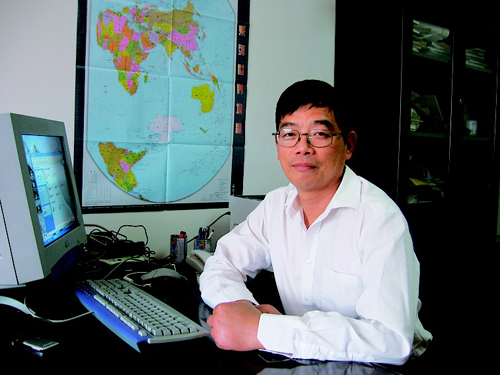 Where is the United States located in relation to China? To the east? No, to the north. What is the name of the ocean that separates China and the United States? The Pacific Ocean? No, the Arctic Ocean. These were the answers given by Hao Xiaoguang, who was invited to attend “Science and China: Expert Lectures” held recently by the Open University of China (OUC). Hao Xiaoguang is a researcher from the Institute of Geodesy and Geophysics (Chinese Academy of Sciences).
Where is the United States located in relation to China? To the east? No, to the north. What is the name of the ocean that separates China and the United States? The Pacific Ocean? No, the Arctic Ocean. These were the answers given by Hao Xiaoguang, who was invited to attend “Science and China: Expert Lectures” held recently by the Open University of China (OUC). Hao Xiaoguang is a researcher from the Institute of Geodesy and Geophysics (Chinese Academy of Sciences).
He is also the creator of the “vertical version of the world map”. In 2014, the "Science and China: Expert Lectures" series invited more than 150 experts and scholars to give lectures. The OUC recorded all the lectures and then broadcast them to wider audiences.

Hao Xiaoguang and his drawing of the vertical version of the world map
By leveraging their respective advantages, the OUC and the Academic Divisions of the Chinese Academy of Sciences jointly launched the "Science and China: Expert Lectures" project in 2012. The project adheres to three principles: win-win cooperation, high-quality resources, and flexible format. It brings together academicians, experts and other high-end talent resources from the Chinese Academy of Sciences and the Chinese Academy of Engineering to fulfill the aims of passing down scientific knowledge to the public, advocating scientific methods, disseminating scientific thought, and upholding the spirit of science through the cross-media communication platform of the OUC Forum. After undergoing a run-in phase in 2012 and an exploration phase in 2013, the lecture series entered a period of stable construction in 2014.
Advancements made by the production team of lectures in 2014 include establishing the proper teaching methods to enhance the depth and breadth of the popularization of science to the public; striving to explain common scientific phenomena around us in simple language; using rich and vivid on-screen images to show the latest achievements in cutting-edge technology; and predicting technological development trends.
In 2014, "Science and China: Expert Lectures" has recorded 11.5 hours of courses given by academicians and experts. The lectures outline the academicians’ and experts’ scientific research in a specialized field, describing their research ideas, research achievements and research development trends. For example, academician Zheng Du’s Exploration of the Natural Environment of the Tibetan Plateau tells a story of previous scientific expeditions to the Tibetan Plateau, describing their experiences and hardships, as well as their scientific research on the natural features and natural zones of the Plateau, calling for everyone to protect the environment and nature of the plateau.

Academician Zheng Du and a Topographical Map of the Tibetan Plateau
In 2014, the project also recorded 15 hours of lectures from the Cutting-Edge Science and Technology Forum organized by the Chinese Academy of Sciences. This series of lectures focuses on the current state of cutting-edge science and technology and forward-looking academic achievements, showing the innovative and pioneering spirit Chinese scientists. The recordings show that the position of Chinese scientists has shifted from followers of western countries to the role of world leaders in the energy, environment and other research fields. For example, in the grip of frequent smog, a forum was held on the topic "atmospheric haze and its control measures". The academicians and experts discussed the mechanisms of the formation of regional haze, conducted research and development into technologies that can be used to control the key pollutants of smog, and provided scientifically feasible policy solutions to the smog pollution.

Researcher He Hong delivering a speech at the "atmospheric haze and its control measures" forum
The recording for the subsequent 73 series of hours of lectures has been completed and they are currently in post-production. They are expected to be produced and broadcast by mid-2015.
By Zhang Ningjuan, the OUC